Corner installation for a toilet: selection tips and installation rules
Most modern apartments do not have sufficient bathroom space. Despite the small dimensions of the bathroom, it should contain key functional items: a bathtub, washbasin and toilet.In a small room it is impossible to place plumbing fixtures in the standard way.
A corner installation for a toilet, often used for arranging a small bathroom, will help solve the problem. In this material we will talk about what such a design is and share the secrets of self-installation of a corner toilet.
The content of the article:
Corner installation: practicality and comfort
Plumbing fixtures are constantly being improved, which has led to the emergence of a unique design wall hung toilet. The practical use of suspended plumbing equipment is characterized by greater comfort and ease of use.
The reliability of the toilet installation is ensured by the installation - a special mounting element.
In practice, the following types of installation systems are used:
- direct, for mounting the toilet on the plane of the walls;
- corner, for installing the structure in the corner of the room.
Both types of installation involve the installation of reliable, stable structures based on a rectangular steel frame.
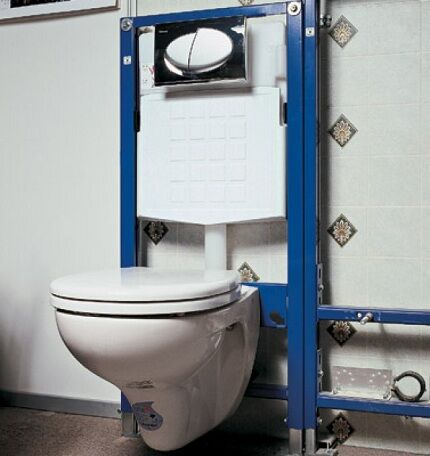
The corner design is of particular interest to modern consumers. A distinctive feature of the system is the presence of four additional pads. They are located at the top and bottom of the structure, at an angle of 45 degrees from the main frame. Thanks to this addition, corner installation allows you to rationally place plumbing fixtures in the bathroom and create block structures.
The presence of additional overlays significantly expands installation possibilities. The consumer can perform installation by fixing the system to the floor and walls (or to one of them), and the fastening can be performed at only one point.
If, when installing a toilet in the corner of a room, the angle size differs slightly from 90 degrees, then the linings are moved apart to the required amount, ensuring a reliable and tight fit of the equipment to the wall.
An important distinguishing feature of the corner version is the drain tank. The element has a triangular shape, in contrast to straight frames with a flat tank. The use of a tank of this shape will have a positive effect on the dimensions and appearance of the system.
Advantages and disadvantages of the corner type
The main difference between the corner design and the standard system is the unusual shape of the cistern. The bowl of the drain design of this model has the shape of a triangle, while maintaining the total volume of the element.
Foreign-made models are also mounted in a corner, while the cistern is not triangular in shape, and the toilet seat is made in the form of a circle, which allows you to sit comfortably on it, turning in any direction.
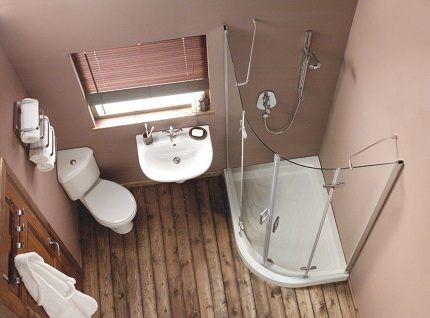
During installation, the drain structure of the corner installation is attached to the corner formed between the 2 walls of the bathroom.
These systems have many advantages:
- They allow you to compactly arrange the necessary appliances in a small bathroom and help create an original design of the room.
- Plumbing fixtures placed in the corners of the room allow you to “round out” the room, freeing up valuable additional space in its central part.
- In the case of a separate bathroom, the use of a corner toilet allows you to place a bidet or sink if necessary.
- The corner system visually gives the impression of a fragile structure. Despite this, an installation of this shape can withstand a load of up to 0.5 tons.
- An additional advantage of the model is that it has a convenient height adjustment function of 4 cm.
The drain bowl, made of solid material, is especially durable because it cannot burst or crack.
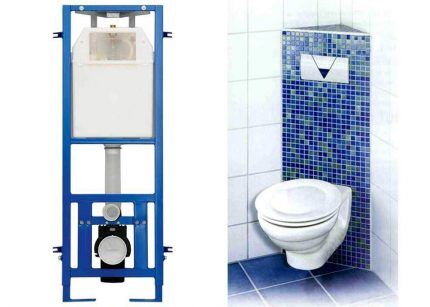
Corner installation of a toilet bowl has several disadvantages that must be taken into account when choosing the optimal design. If you try to install it in a standard bathroom, there will not be enough free space left.
As a result, the apartment owner will receive an insignificant gain in space and inconvenience of operation: when using the equipment for its intended purpose, the legs of a sitting person will rest against the wall.
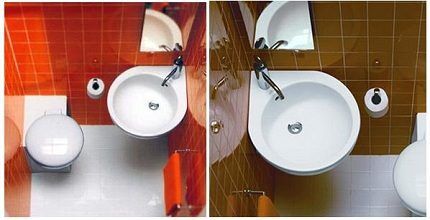
When installing a wall-mounted product, it should be taken into account that the wall must support the weight of the toilet, a full flush cistern and the person who uses the toilet for its intended purpose. For drywall, this can be an overwhelming task.
In the case where the installation of a corner installation needs to be done on a plasterboard wall, a wooden embed is placed under the cladding in advance.
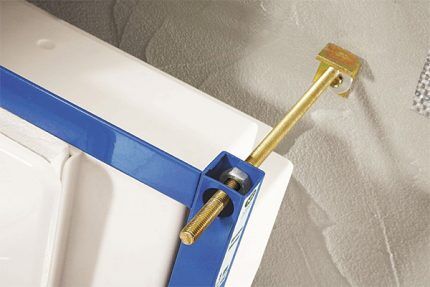
What should you consider when choosing?
To choose a reliable and convenient corner toilet with a tank, you need to pay attention to certain parameters.
With knowledge, you will purchase the optimal model of plumbing equipment, which will not cause inconvenience or discomfort during further use of the product.

Ways to position the toilet
The location for the future installation of the toilet should be determined in advance. When choosing a model, you need to clearly understand how it will be located in the bathroom:
- The toilet can be positioned parallel to the wall of the bathroom, while the cistern will be slightly offset to the side.
- You can install the toilet on the bisector of the corner of the room, then the tank will be placed at an angle of 45 or 90 degrees.
If the bathroom riser is located along the wall, installation of the corner structure becomes more difficult. The use of additional wiring in the form of a hose or corrugation will help solve the problem.
Connecting plumbing equipment
To successfully install a corner toilet, you must first make sure that it is possible to connect plumbing equipment to communications. Cold water can be supplied to the corner model in one of two possible ways: from below or from the side.
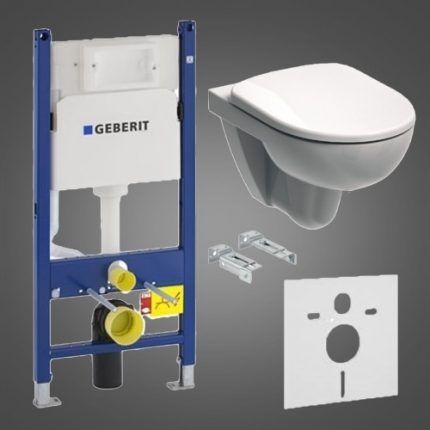
To ensure that during the installation of equipment there is no need to use additional connections, it is necessary to choose a model that will initially correspond to the communications available in the bathroom.
Design of corner types of plumbing fixtures
Often a bathroom is designed in a certain style or has a specific color scheme.In this case, you need to choose a corner toilet model taking into account the requirements for the appearance of the plumbing equipment.
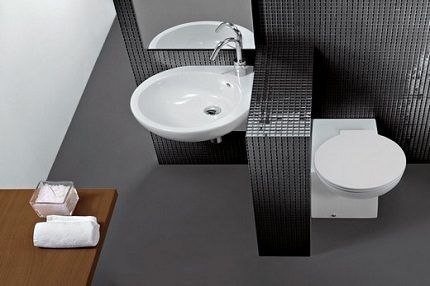
Modern manufacturers offer a variety of design additions and elements that will give the standard model a special chic and originality: inlays, transparent covers, decorative ornaments and much more.
Selecting toilet parameters
Corner toilets can come in a variety of sizes. To choose the optimal model, you need to carefully measure the location where the future toilet will be located. The minimum area required to install such plumbing equipment is 2 square meters.
When choosing a toilet model, you need to remember that it should look organic with other plumbing items. In addition to the toilet, the combined bathroom has a washbasin and a bathtub.
Which material is better?
It is necessary to choose a corner toilet taking into account the material that was used in its manufacture. Modern domestic and foreign manufacturers offer a varied palette of materials. Toilets are made from traditional earthenware, tempered glass, porcelain and durable plastic.
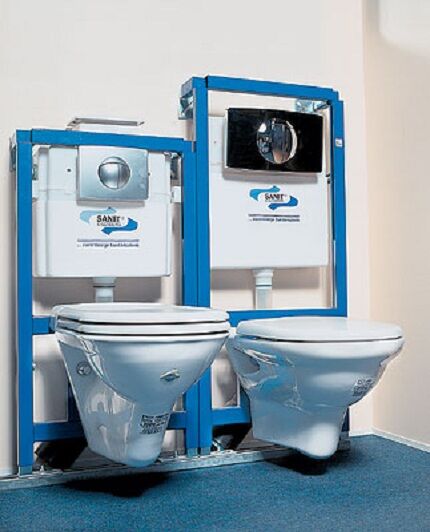
The faience or ceramic model is considered the most practical and in demand among consumers. One of the main advantages of the product is its visual appeal and versatility. An aesthetic ceramic toilet will fit perfectly into the design of a modern bathroom.
Is the manufacturing company important?
If you want to purchase a reliable corner toilet design, but do not have the opportunity to spend a significant amount on its purchase, opt for domestic products. Imported plumbing equipment is distinguished by its visual appeal and higher cost.
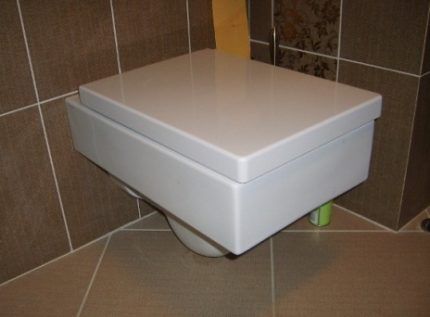
High-quality sanitary ware supplied to Russia from Italy, Germany and Switzerland is in high demand among modern consumers.
Among the most popular manufacturers of corner-mounted plumbing equipment, it is worth noting foreign companies that produce high-quality products under the following trademarks:
- Geberit (Switzerland).
- Grohe (Germany).
- Viega (Germany).
Also, many lovers of high-quality plumbing fixtures prefer products from the brands Roca, Vitra, Gustavsberg, Villeroy & Boch, Cersanit, Laufen.
Multifunctionality of hanging structures
Manufacturers are increasingly equipping corner toilet models that are in demand today with convenient additional functions, which attracts the attention of plumbing buyers. For example, you can purchase a modern corner design with a hygienic shower.
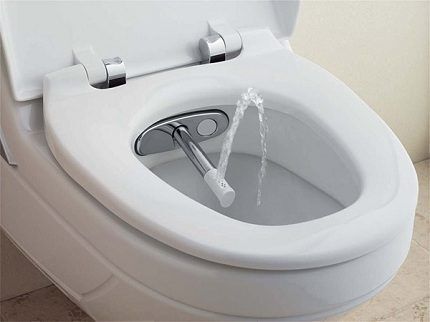
A variety of additional features significantly increase the level of comfort and convenience when using the product.Despite the higher price of plumbing equipment with additional functions, the demand for such products is constantly growing.
Cost of equipment with installation
The price of an aesthetic corner toilet differs significantly from the cost of conventional plumbing models with rectangular cisterns. A stylish toilet for installation in the corner of the bathroom will cost you 2 times more.
If a standard model today costs from 3,000 rubles. up to 20,000 rubles, then the corner structure is offered to consumers ranging from 6,000 rubles. up to 30,000 rub.
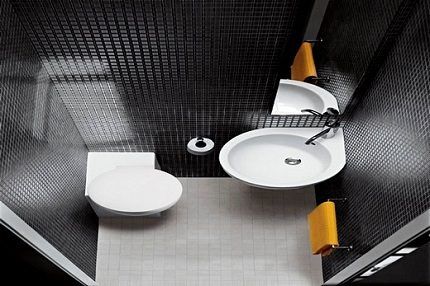
Having collected all the above information together, you need to think carefully about whether the corner design is suitable for a particular bathroom. If no obstacles to its purchase and installation are identified, you can go to a specialized plumbing supply store and purchase a toilet model that meets your requirements.
Types and nuances of installation
Features of installing a corner toilet model differ significantly from the installation process standard toilet. To operate this structure, it is necessary to connect the sewerage system in a special way. If you are the owner of an apartment that is located in an old building, then the riser is located parallel to the wall of the room. In this case, installing a corner toilet will create certain difficulties.
You can solve the problem using corrugated pipe or a special extension cord. Using these additional elements, you can connect the corner structure to the general sewer system.
It is optimal to use short-length corrugation for this purpose.When it becomes clogged, it has to be cleaned, so the shorter the pipe, the easier the cleaning process.
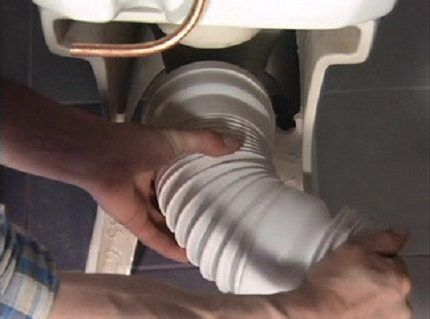
In some cases, the toilet is installed on a special elevation - a pre-mounted pedestal. This is necessary not for aesthetics, but for the correct supply of cold water to this plumbing equipment.
The corner toilet can be securely fixed to the floor surface or hang from the wall bathroom. For this purpose, an installation is used - a suspended frame structure that allows you to install the equipment in a corner.
Required materials and tools
To successfully complete the upcoming installation work on installing a corner toilet you will need:
- perforator;
- water supply hose;
- corrugated pipe;
- sealant;
- bolts to secure the structure to the surface.
It is recommended to select the sealant to match the color of the toilet installed in the bathroom. Otherwise, all the designer’s efforts can be ruined.
Installation of floor structure
At the first stage of installation, it is necessary to adjust the holes of the equipment bowl and sewer drain. For this purpose, one end of the corrugated tube used must be installed on the sewer hole, and the other on the hole in the plumbing equipment.

At the next stage, it is necessary to secure the structure to a special podium or to a horizontal floor surface. To do this, you first need to mark the place for the fasteners. Holes are made at these marks using a puncher.Then screw the toilet to the floor using bolts.
After the equipment is securely fastened, the drain tank is installed. It is important that the drain holes are aligned. It is strictly forbidden to move the silicone gasket, as this can destroy the protection against water leakage between the base of the toilet and the tank. Now you can tighten the screws.

Then, using a special flexible hose, the water supply is connected to the toilet. If there are any cracks at its base, they must be carefully sealed with sealant to prevent leakage. Now you can connect the water and check the tank for leaks. If no leaks are observed during the draining process, the toilet has been installed correctly.
Installation of a corner wall hung toilet
A wall-hung model, installed in the corner of the bathroom, takes up a minimal amount of space, so the choice of consumers often falls on it. If we compare the process of installing a corner structure with the installation of standard equipment, then there is not much difference in them.
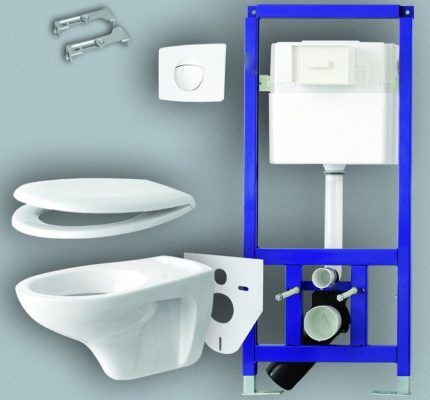
Before installing the corner structure, communication pipes and hoses must be installed. The corner installation of the toilet must be stationary, so it is better to use a metal tube to connect it to the cold water supply.
You can install a drain using a corrugated pipe.
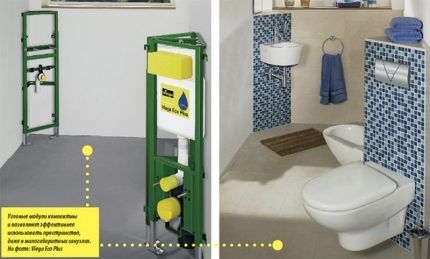
The toilet must be mounted on a special frame structure. The main task when installing the structure is to ensure the immobility and strength of the installation.
For this you need attach installation to the floor and wall of the room using anchor bolts. The final stage is connecting the system to communications.
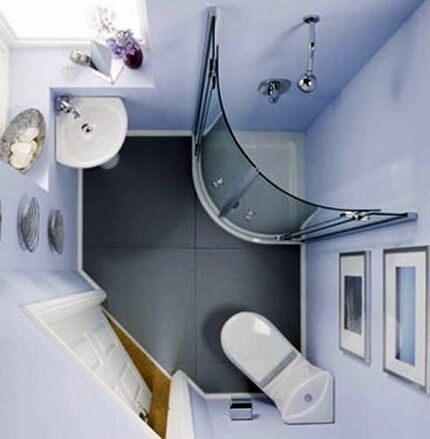
After installing the hanging plumbing fixture, the bowl of the product should be at a height of 40 to 50 cm from the floor. At this stage, the installation process is considered complete.
The designers of the corner installation provided for self-braking of the module's retractable supports. This makes the installation of plumbing equipment easier and more convenient, as it frees the specialist from unnecessary actions. The internal part of the module is characterized by the presence of space sufficient for the distribution of all communications.
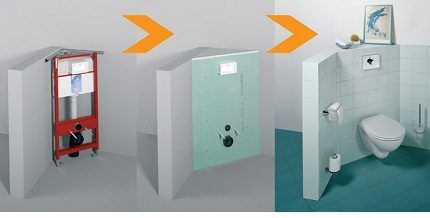
Maintenance and repair of the corner system
The technology for installing a corner installation system involves hidden installation of communications and various elements. Only the toilet remains publicly accessible, and the rest of the household is covered with cladding panels or hidden behind a solid wall.
In this regard, many questions arise regarding the maintenance and repair of corner installation elements.According to the manufacturers, maintenance can be carried out through the service hatch, which provides access to all elements of the system. It is used to dismantle and replace equipment that has become unusable.
Manufacturers guarantee that in the event of a breakdown of the cistern hidden behind the wall, the property of neighbors will remain undamaged. The body of the storage tank is made of solid material and cannot burst, crack or deform. The drainage mechanism in the tank is equipped with an emergency overflow channel, which, in the event of a malfunction, will ensure water drainage.
Conclusions and useful video on the topic
Useful practical tips on choosing and installing a corner toilet can be gleaned from the video.
Advantages and types of installations:
Installation of the installation in a plasterboard partition:
Do-it-yourself installation installation:
Corner installation of a toilet allows you to advantageously change the space of any bathroom by freeing up its central part. The capacity and functionality of the room increases.
Modern manufacturers offer a variety of corner designs. Taking into account the characteristics of the room and interior, you can choose the optimal model of a corner toilet. The designs have gained popularity due to the presence of a special drainage system, compactness, durability and ease of installation.
Are you looking for a corner installation for your home, but can’t decide? Or do you already have experience installing similar structures? Please leave comments, share valuable tips, and ask questions in the block below.




My husband and I decided on a corner wall-hung toilet because we have a small bathroom and wanted to leave as much space as possible for the bathtub. We chose a model from Viega - very compact and beautiful, if you can say that about a toilet. The price, of course, is not small, but the toilet will last for more than one day. And the installation was entrusted to professionals.
Now we are considering options for installing a toilet in the corner of the bathroom, the most acceptable option is a corner cistern, it saves more space and is the most convenient. I have a question of a different nature: wall-hung toilets, which are subject to a large pull-out force when a person sits down, have become very popular. In terms of practical use, can anyone say something about whether the faience or ceramic toilet itself does not become loose over time and does not break off?
Thank you very much for your collection of tips! I went to the store to buy.